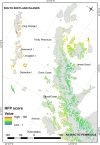High Resolution Spatial Mapping of Human Footprint across Antarctica and Its Implications for the Strategic Conservation of Avifauna
- PMID: 28085889
- PMCID: PMC5235374
- DOI: 10.1371/journal.pone.0168280
High Resolution Spatial Mapping of Human Footprint across Antarctica and Its Implications for the Strategic Conservation of Avifauna
Erratum in
-
Correction: High Resolution Spatial Mapping of Human Footprint across Antarctica and Its Implications for the Strategic Conservation of Avifauna.PLoS One. 2017 Mar 3;12(3):e0173649. doi: 10.1371/journal.pone.0173649. eCollection 2017. PLoS One. 2017. PMID: 28257430 Free PMC article.
Abstract
Human footprint models allow visualization of human spatial pressure across the globe. Up until now, Antarctica has been omitted from global footprint models, due possibly to the lack of a permanent human population and poor accessibility to necessary datasets. Yet Antarctic ecosystems face increasing cumulative impacts from the expanding tourism industry and national Antarctic operator activities, the management of which could be improved with footprint assessment tools. Moreover, Antarctic ecosystem dynamics could be modelled to incorporate human drivers. Here we present the first model of estimated human footprint across predominantly ice-free areas of Antarctica. To facilitate integration into global models, the Antarctic model was created using methodologies applied elsewhere with land use, density and accessibility features incorporated. Results showed that human pressure is clustered predominantly in the Antarctic Peninsula, southern Victoria Land and several areas of East Antarctica. To demonstrate the practical application of the footprint model, it was used to investigate the potential threat to Antarctica's avifauna by local human activities. Relative footprint values were recorded for all 204 of Antarctica's Important Bird Areas (IBAs) identified by BirdLife International and the Scientific Committee on Antarctic Research (SCAR). Results indicated that formal protection of avifauna under the Antarctic Treaty System has been unsystematic and is lacking for penguin and flying bird species in some of the IBAs most vulnerable to human activity and impact. More generally, it is hoped that use of this human footprint model may help Antarctic Treaty Consultative Meeting policy makers in their decision making concerning avifauna protection and other issues including cumulative impacts, environmental monitoring, non-native species and terrestrial area protection.
Conflict of interest statement
The authors have declared that no competing interests exist.
Figures





References
-
- Harris CM, Lorenz K, Fishpool LDC, Lascelles B., Cooper J, Coria NR, et al. Important Bird Areas in Antarctica BirdLife International and Environmental Research & Assessment Ltd; Cambridge; 2015.
-
- Hughes KA, Convey P (2010) The protection of Antarctic terrestrial ecosystems from inter- and intra-continental transfer of non-indigenous species by human activities: a review of current systems and practices. Global Environ Change 2010; 20:96–112.
-
- Tin T, Fleming ZL, Hughes KA, Ainley DG, Convey P, Moreno, et al. Impacts of local human activities on the Antarctic environment. Antarct. Sci. 2009; 21:3–33.
MeSH terms
LinkOut - more resources
Full Text Sources
Other Literature Sources

